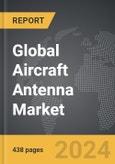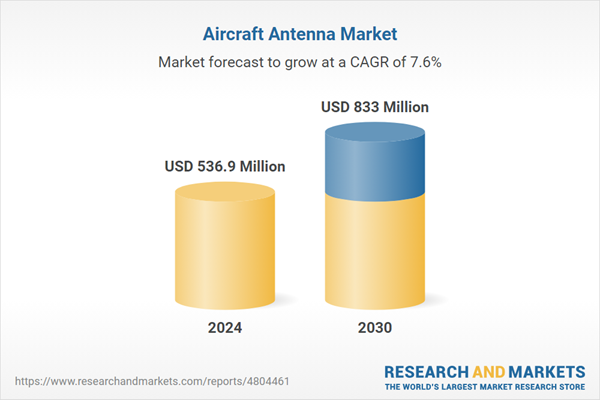The global market for Aircraft Antenna was valued at US$536.9 Million in 2024 and is projected to reach US$833.0 Million by 2030, growing at a CAGR of 7.6% from 2024 to 2030. This comprehensive report provides an in-depth analysis of market trends, drivers, and forecasts, helping you make informed business decisions. The report includes the most recent global tariff developments and how they impact the Aircraft Antenna market.
Technological advancements have significantly enhanced the capabilities of aircraft antennas, integrating them with modern avionics systems to support a wide range of applications. Modern antennas are equipped with advanced features like multi-band and multi-functional capabilities, enabling them to handle various frequencies and communication protocols simultaneously. This multi-functionality is particularly beneficial for modern aircraft, which rely on a sophisticated array of systems for navigation, communication, and safety. Innovations such as phased array antennas, which electronically steer the beam without moving parts, provide enhanced performance and reliability. Additionally, the integration of satellite communication (Satcom) antennas allows for global connectivity, supporting real-time data transmission for in-flight entertainment, internet access, and critical operational communications. These advancements have not only improved the efficiency and safety of aircraft operations but also enhanced passenger experience by providing seamless connectivity during flights.
The growth in the aircraft antenna market is driven by several factors. Technological advancements in antenna design and materials have significantly improved performance and durability, leading to greater adoption in modern aircraft. The increasing demand for high-speed, reliable in-flight connectivity has spurred the development and integration of advanced Satcom antennas, catering to both passenger entertainment needs and critical communication requirements. The expansion of the global aviation industry, particularly the rise in commercial air travel and the growth of low-cost carriers, has further boosted the demand for efficient communication and navigation systems, including antennas. Additionally, regulatory requirements for enhanced safety and communication standards have mandated the use of advanced antennas, ensuring compliance and operational efficiency. The military sector also contributes to market growth, with continuous investments in upgrading and maintaining sophisticated communication systems for defense aircraft. Moreover, the trend towards more connected and automated aircraft systems, as part of the broader move towards digital transformation in aviation, is driving the adoption of next-generation antennas. These factors collectively propel the growth of the aircraft antenna market, highlighting its critical role in the evolving landscape of aviation technology.
Segments: Wing Type (Fixed, Rotary); Application (Navigation & Surveillance, Communication); End-Use (Aftermarket, OEMs).
Geographic Regions/Countries: World; USA; Canada; Japan; China; Europe; France; Germany; Italy; UK; Spain; Russia; Rest of Europe; Asia-Pacific; Australia; India; South Korea; Rest of Asia-Pacific; Latin America; Argentina; Brazil; Mexico; Rest of Latin America; Middle East; Iran; Israel; Saudi Arabia; UAE; Rest of Middle East; Africa.
The analysts continuously track trade developments worldwide, drawing insights from leading global economists and over 200 industry and policy institutions, including think tanks, trade organizations, and national economic advisory bodies. This intelligence is integrated into forecasting models to provide timely, data-driven analysis of emerging risks and opportunities.
Global Aircraft Antenna Market - Key Trends & Drivers Summarized
Aircraft antennas are critical components of an aircraft's communication, navigation, and surveillance systems, ensuring seamless connectivity and operational efficiency. These antennas come in various shapes and sizes, each designed to serve specific functions such as VHF (Very High Frequency) communication, GPS (Global Positioning System) navigation, radar operations, and satellite communications. The design and placement of aircraft antennas are crucial to minimize aerodynamic drag while maximizing signal strength and coverage. Typically, they are strategically installed on the aircraft's fuselage, wings, or tail to avoid interference and ensure clear signal transmission and reception. The materials used in manufacturing these antennas are chosen for their durability and resistance to harsh environmental conditions, ensuring reliable performance throughout the aircraft's operational life.Technological advancements have significantly enhanced the capabilities of aircraft antennas, integrating them with modern avionics systems to support a wide range of applications. Modern antennas are equipped with advanced features like multi-band and multi-functional capabilities, enabling them to handle various frequencies and communication protocols simultaneously. This multi-functionality is particularly beneficial for modern aircraft, which rely on a sophisticated array of systems for navigation, communication, and safety. Innovations such as phased array antennas, which electronically steer the beam without moving parts, provide enhanced performance and reliability. Additionally, the integration of satellite communication (Satcom) antennas allows for global connectivity, supporting real-time data transmission for in-flight entertainment, internet access, and critical operational communications. These advancements have not only improved the efficiency and safety of aircraft operations but also enhanced passenger experience by providing seamless connectivity during flights.
The growth in the aircraft antenna market is driven by several factors. Technological advancements in antenna design and materials have significantly improved performance and durability, leading to greater adoption in modern aircraft. The increasing demand for high-speed, reliable in-flight connectivity has spurred the development and integration of advanced Satcom antennas, catering to both passenger entertainment needs and critical communication requirements. The expansion of the global aviation industry, particularly the rise in commercial air travel and the growth of low-cost carriers, has further boosted the demand for efficient communication and navigation systems, including antennas. Additionally, regulatory requirements for enhanced safety and communication standards have mandated the use of advanced antennas, ensuring compliance and operational efficiency. The military sector also contributes to market growth, with continuous investments in upgrading and maintaining sophisticated communication systems for defense aircraft. Moreover, the trend towards more connected and automated aircraft systems, as part of the broader move towards digital transformation in aviation, is driving the adoption of next-generation antennas. These factors collectively propel the growth of the aircraft antenna market, highlighting its critical role in the evolving landscape of aviation technology.
Report Scope
The report analyzes the Aircraft Antenna market, presented in terms of units. The analysis covers the key segments and geographic regions outlined below.Segments: Wing Type (Fixed, Rotary); Application (Navigation & Surveillance, Communication); End-Use (Aftermarket, OEMs).
Geographic Regions/Countries: World; USA; Canada; Japan; China; Europe; France; Germany; Italy; UK; Spain; Russia; Rest of Europe; Asia-Pacific; Australia; India; South Korea; Rest of Asia-Pacific; Latin America; Argentina; Brazil; Mexico; Rest of Latin America; Middle East; Iran; Israel; Saudi Arabia; UAE; Rest of Middle East; Africa.
Key Insights:
- Market Growth: Understand the significant growth trajectory of the Fixed segment, which is expected to reach US$577.1 Million by 2030 with a CAGR of a 7.5%. The Rotary segment is also set to grow at 7.8% CAGR over the analysis period.
- Regional Analysis: Gain insights into the U.S. market, valued at $197.7 Million in 2024, and China, forecasted to grow at an impressive 8.8% CAGR to reach $88.0 Million by 2030. Discover growth trends in other key regions, including Japan, Canada, Germany, and the Asia-Pacific.
Why You Should Buy This Report:
- Detailed Market Analysis: Access a thorough analysis of the Global Aircraft Antenna Market, covering all major geographic regions and market segments.
- Competitive Insights: Get an overview of the competitive landscape, including the market presence of major players across different geographies.
- Future Trends and Drivers: Understand the key trends and drivers shaping the future of the Global Aircraft Antenna Market.
- Actionable Insights: Benefit from actionable insights that can help you identify new revenue opportunities and make strategic business decisions.
Key Questions Answered:
- How is the Global Aircraft Antenna Market expected to evolve by 2030?
- What are the main drivers and restraints affecting the market?
- Which market segments will grow the most over the forecast period?
- How will market shares for different regions and segments change by 2030?
- Who are the leading players in the market, and what are their prospects?
Report Features:
- Comprehensive Market Data: Independent analysis of annual sales and market forecasts in US$ Million from 2024 to 2030.
- In-Depth Regional Analysis: Detailed insights into key markets, including the U.S., China, Japan, Canada, Europe, Asia-Pacific, Latin America, Middle East, and Africa.
- Company Profiles: Coverage of players such as Honeywell International, Inc., Cobham PLC, Amphenol Corporation, Boeing Company, The, Gilat Satellite Networks and more.
- Complimentary Updates: Receive free report updates for one year to keep you informed of the latest market developments.
Some of the 43 companies featured in this Aircraft Antenna market report include:
- Honeywell International, Inc.
- Cobham PLC
- Amphenol Corporation
- Boeing Company, The
- Gilat Satellite Networks
- Smiths Interconnect
- Tecom Co., Ltd.
- Astronics Corporation
- Dayton-Granger, Inc.
- MT Aerospace AG
- ACR Electronics, Inc. (Artex)
- Emergency Beacon Corporation
- Hr Smith Group
- Airways Corporation New Zealand Limited
- Committee for Aviation and Space Industry Development (CASID)
Tariff Impact Analysis: Key Insights for 2025
Global tariff negotiations across 180+ countries are reshaping supply chains, costs, and competitiveness. This report reflects the latest developments as of April 2025 and incorporates forward-looking insights into the market outlook.The analysts continuously track trade developments worldwide, drawing insights from leading global economists and over 200 industry and policy institutions, including think tanks, trade organizations, and national economic advisory bodies. This intelligence is integrated into forecasting models to provide timely, data-driven analysis of emerging risks and opportunities.
What’s Included in This Edition:
- Tariff-adjusted market forecasts by region and segment
- Analysis of cost and supply chain implications by sourcing and trade exposure
- Strategic insights into geographic shifts
Buyers receive a free July 2025 update with:
- Finalized tariff impacts and new trade agreement effects
- Updated projections reflecting global sourcing and cost shifts
- Expanded country-specific coverage across the industry
Table of Contents
I. METHODOLOGYII. EXECUTIVE SUMMARY2. FOCUS ON SELECT PLAYERSIII. MARKET ANALYSISCANADAITALYSPAINRUSSIAREST OF EUROPESOUTH KOREAREST OF ASIA-PACIFICARGENTINABRAZILMEXICOREST OF LATIN AMERICAIV. COMPETITION
1. MARKET OVERVIEW
3. MARKET TRENDS & DRIVERS
4. GLOBAL MARKET PERSPECTIVE
UNITED STATES
JAPAN
CHINA
EUROPE
FRANCE
GERMANY
UNITED KINGDOM
ASIA-PACIFIC
AUSTRALIA
INDIA
LATIN AMERICA
MIDDLE EAST
AFRICA
Companies Mentioned (Partial List)
A selection of companies mentioned in this report includes, but is not limited to:
- Honeywell International, Inc.
- Cobham PLC
- Amphenol Corporation
- Boeing Company, The
- Gilat Satellite Networks
- Smiths Interconnect
- Tecom Co., Ltd.
- Astronics Corporation
- Dayton-Granger, Inc.
- MT Aerospace AG
- ACR Electronics, Inc. (Artex)
- Emergency Beacon Corporation
- Hr Smith Group
- Airways Corporation New Zealand Limited
- Committee for Aviation and Space Industry Development (CASID)
Table Information
| Report Attribute | Details |
|---|---|
| No. of Pages | 438 |
| Published | April 2025 |
| Forecast Period | 2024 - 2030 |
| Estimated Market Value ( USD | $ 536.9 Million |
| Forecasted Market Value ( USD | $ 833 Million |
| Compound Annual Growth Rate | 7.6% |
| Regions Covered | Global |









